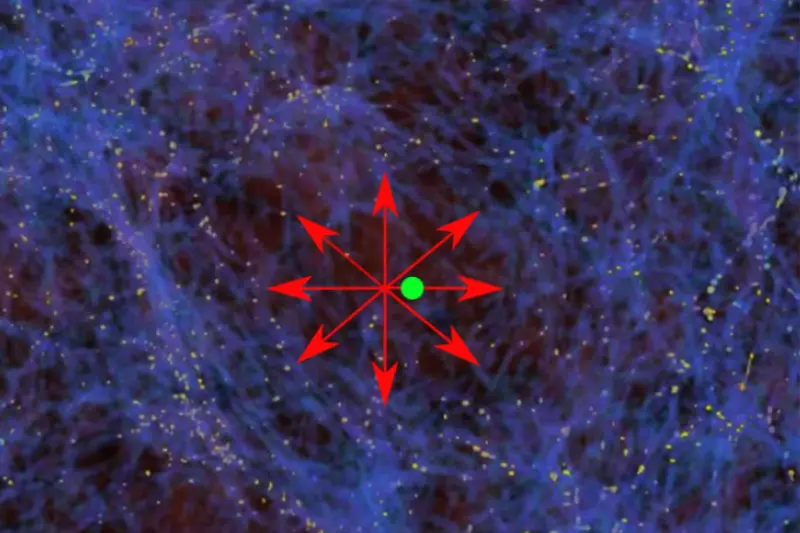
Earth and the surrounding Milky Way galaxy may be sitting inside a cosmic void—a "mysterious giant hole"—that could be speeding up the universe's expansion in our region compared to others,
This is the argument of researchers presented at the Royal Astronomical Society's National Astronomy Meeting (NAM) in Durham.
The notion may help explain one of cosmology's most puzzling problems: the so-called "Hubble tension"; the mismatch between two different ways of measuring how fast the universe is expanding.
What Is the Hubble Tension?
The Hubble constant, named after Edwin Hubble who first defined it in 1929, describes the rate at which the universe is expanding. It is calculated by measuring how fast galaxies are moving away from us and how far they are.
But there's a catch. When scientists use data from the early universe—such as measurements from the cosmic microwave background (CMB)—they get a slower expansion rate than when they measure more recent, local data. This discrepancy is the Hubble tension.
Paper author and cosmologist Indranil Banik of the University of Portsmouth, England, believes this inconsistency might be explained if our galaxy lies within a huge underdense region of space.
"A potential solution to this inconsistency is that our galaxy is close to the center of a large, local void," explained Dr Banik.
"It would cause matter to be pulled by gravity towards the higher density exterior of the void, leading to the void becoming emptier with time.
"As the void is emptying out, the velocity of objects away from us would be larger than if the void were not there. This therefore gives the appearance of a faster local expansion rate."
In other words, if we're inside a vast low-density region, it might make it look like space is expanding faster in our neighbourhood than it is elsewhere—solving the Hubble tension without needing to rewrite the laws of physics.
"The Hubble tension is largely a local phenomenon, with little evidence that the expansion rate disagrees with expectations in the standard cosmology further back in time," Banik added.
"So a local solution like a local void is a promising way to go about solving the problem."
What Would This Void Look Like?
For this theory to work, our solar system would need to be near the center of a void roughly a billion light-years across.
Direct galaxy counts support the idea—astronomers have noticed that our local region seems to have fewer galaxies than nearby parts of the universe.
Still, the idea is controversial. The standard model of cosmology assumes that matter should be spread fairly evenly across such large scales. A void of this size and depth doesn't fit easily within that framework.
The Sound of the Big Bang
Supporting evidence for the void theory comes from so-called baryon acoustic oscillations (BAOs), often described as "the sound of the Big Bang."
"These sound waves travelled for only a short while before becoming frozen in place once the universe cooled enough for neutral atoms to form," Dr Banik explained.
"They act as a standard ruler, whose angular size we can use to chart the cosmic expansion history."
According to Banik, BAO measurements slightly shift in a universe with a local void. The gravitational effects of such a void add a small redshift to the light from distant objects—on top of the redshift caused by the overall expansion of the universe.
"By considering all available BAO measurements over the last 20 years, we showed that a void model is about one hundred million times more likely than a void-free model with parameters designed to fit the CMB observations taken by the Planck satellite, the so-called homogeneous Planck cosmology."
What Comes Next?
To test the theory further, astronomers will compare the void model against other independent methods of tracking the universe's expansion, such as cosmic chronometers. These involve studying old galaxies that no longer form stars.
By examining the types of stars these galaxies contain—since massive stars burn out more quickly—scientists can estimate their ages. Combining these ages with the galaxies' redshifts reveals how much the universe has expanded while the light was traveling to us, offering another way to trace the cosmic expansion history.
If future observations continue to align with the void model, it could fundamentally reshape our understanding of our place in the cosmos—and just how unusual our corner of the universe might be.
Do you have a tip on a science story that Newsweek should be covering? Do you have a question about stars? Let us know via [email protected].
Reference
Banik, I., Desmond, H., Valentino, E. D., & Shanks, T. (2025). Theoretical and observational approaches to the Hubble tension. National Astronomy Meeting 2025, Durham University. https://conference.astro.dur.ac.uk/event/7/sessions/90/#20250709
